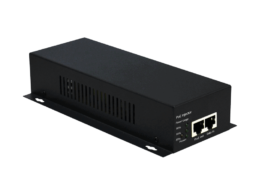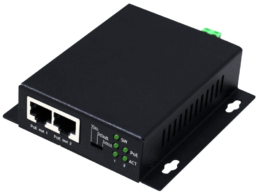Ethernet ports have a limited range of 100 meters. You might wonder, why only 100 meters? The problem is a bit technical. IEEE designed it to provide technology within a 100-meter range without affecting bandwidth and data speed. As per principles of electromagnetic physics, Ethernet has a limited capacity. Suppose you go out of the range, the single-to-noise ratio decreases, and resistance increases. This will lead to low-quality signals.
Who wants to limit technology? Undoubtedly, everyone wants unlimited range for Ethernet due to the fast data connection, but remember, everything has an upper and lower limit. You will lose signals when you cross the boundary of 100 meters of Ethernet. This rule applies to all other types of technologies as well.
Today, we will briefly overview why Ethernet has a 100-meter range.
Understanding the basic science of Ethernet
What is Ethernet Technology?
Ethernet is a popular choice for networking in enterprises and data centers. Do you know why? Because it provides the users with a high-speed data connection and a high power supply.
Ethernet technology connects multiple computers over the LAN(local area network). The use of Ethernet cables is a medium that enables this technology. It works based on the IEEE 802.3 standard, the Ethernet standard.
Four types of Ethernet networks
Multiple Ethernet networks depend on the speed of data connection and relevant aspects. Let’s have a quick go-through of the networks.
Fast Ethernet
Fast Ethernet enables you to get data speed at a rate of 100 Mbps. It is certainly better than 10 Mbps, but there is Gigabit Ethernet for higher speeds. It might comprise twisted pair cables or fiber optic cable to transfer the data. It works on the principles of CSMA/CD media access control protocols and can use 10BaseT cabling. We call Fast Ethernet 100BaseT.
Gigabit Ethernet
Gigabit Ethernet is another fascinating network of Ethernet technology. Do you know why it is unique? I suppose yes. As the name indicates, Gigabit Ethernet can offer you up to 1GB per second of data speed. Enough for smaller networks!
It is ten times faster than the 100BaseT. We also call it “1000BaseT,” referring to 1000 Mbps data speed.
Get a detailed overview of Fast and Gigabit Ethernet here—What Is Fast Ethernet and Gigabit Ethernet?
10 Gigabit Ethernet
It is not precisely a separate network, but we can call it a variant of Gigabit Ethernet, but a faster and more reliable option. The IEEE 802.3ae standard introduced ten times faster than the 1000BaseT network. High-data applications and data storage centers use this technology for better data compatibility.
Here is a guide for 10G Ethernet —What is 10GB Ethernet used for?
Switch Ethernet
Switch networks comprise the Ethernet switches. Do you know what an Ethernet switch can do for you? Simply put, it can connect multiple devices at a time and provide them with power and data, unlike the Ethernet cabling system.
To understand the use of an Ethernet switch, get a guide here— What is An Ethernet Switch Used for?
Five different standards of Ethernet technology
Here are some popular Ethernet standards that would help determine this technology.
- IEEE 802.3 refers to 10Mbps bandwidth with UTP cable(Unshielded Twisted Port)
- IEEE 802.3u refers to 100Mbps bandwidth with UTP cable.
- IEEE 802.3z operates the 1000Mbps bandwidth while the cable type is optic fiber.
- IEEE 802.3ab operates at 1000Mbps bandwidth, but the cable is UTP
- IEEE 802.3an works at 10GBps bandwidth, and the cable type is UTP.
Why do we use the Ethernet network?
Good question. Many people have such questions. They want to know why they should convert from other networks to Ethernet. The ultimate reason is again the data speed—10GB per second. Don’t you think it is more than enough for your network? This fact compels every data center to employ this technology.
Get a quick guide here—How Much Speed Will My PoE Switch Provide?
Why is Ethernet Limited to 100 meters?
Ethernet’s upper limit of range is 100 meters. You might ask why, when, and how exactly. Am I right? Let’s go through it step by step.
What are the lengths of different Ethernet ports?
Every Ethernet port has a different range. It depends on the bandwidth and data speed to increase or decrease the length. However, I have listed the maximum size for each Ethernet port so that I can understand it better. Have a look!
- Cat3— 100 meters with 10 Mbps speed
- Cat5— 100 meters with 10/100Mbps
- Cat6— 100 meters with 1000Mbps
- Cat7—100 meters with 10GB per second
- Cat8— 30 meters with 40GB per second
Based on the stats, you can decide which Ethernet port is suitable from every aspect.
Two reasons why it is limited to 100 meters.
The answer is not that simple. I have listed two scenarios to discuss it in detail and help you understand the exact reason.
Reason 1
- Since Ethernet uses twisted ports, such as copper, there is an electrical cross-talk mechanism. The magnetic field of one wire interacts with the other, leading to a small voltage. This voltage diminishes the signals once the 100-meter range has crossed.
Reason 2
- The second possible scenario refers to an increase in resistance. Copper wires have very little resistance until they are 100 meters long; as soon as you cross that threshold, the resistance increases, leading to a diminution of signals.
Can I increase the Ethernet length?
Yes, there are several mechanisms to increase the Ethernet length. You can use PoE extenders if you are in the PoE network. Signal amplifiers always play a significant role in it. However, optic fiber can make it possible to achieve higher distance feats quite effectively.
What are the advantages and disadvantages of Ethernet technology?
Ethernet technology —the most popular technology today!
Every data center uses it because of its low cost and high data speed. The great thing about it is the dual use of ports. Whether you need a high-speed or high-power supply, try using Ethernet.
4 Advantages of Ethernet
- High-speed data connection. 100GB per second is no longer a dream today!
- Highly secure. Several security protocols, such as SSL and SSH, keep hackers miles away.
- Reliable network. No radio frequencies can interrupt—no tensions about slowdowns.
- High-performance network with low use of power
3 Disadvantages of Ethernet
- Limited to 100 meters
- Extra expenses when you want to install some additional components
- Need professional IT services to install.






